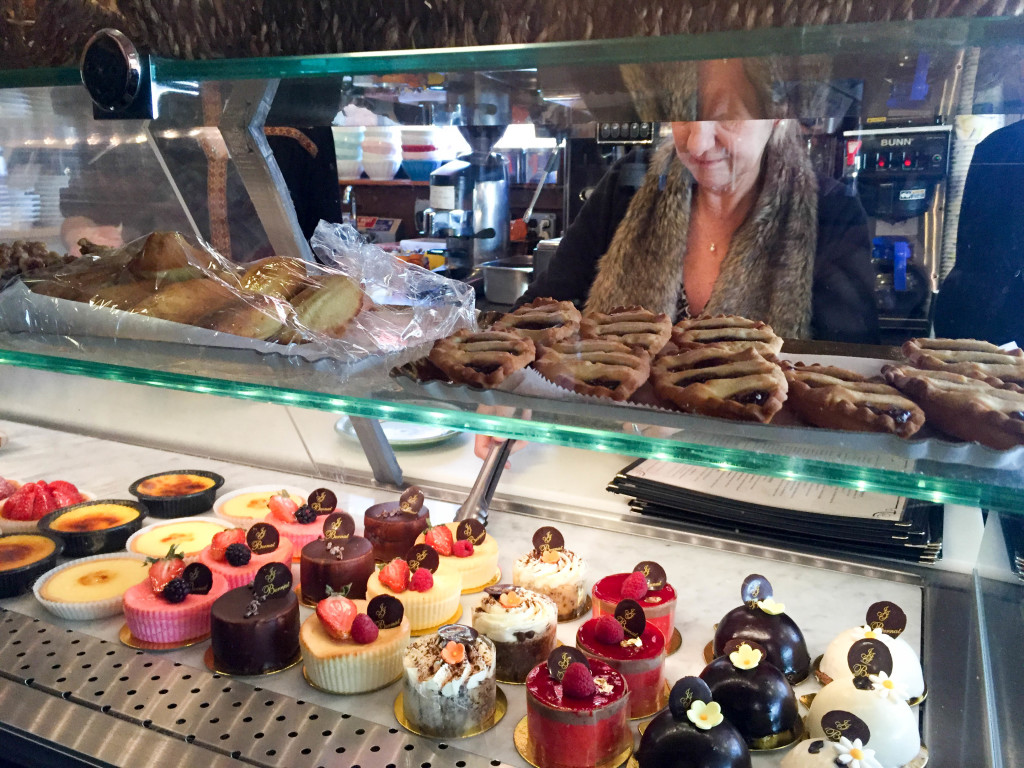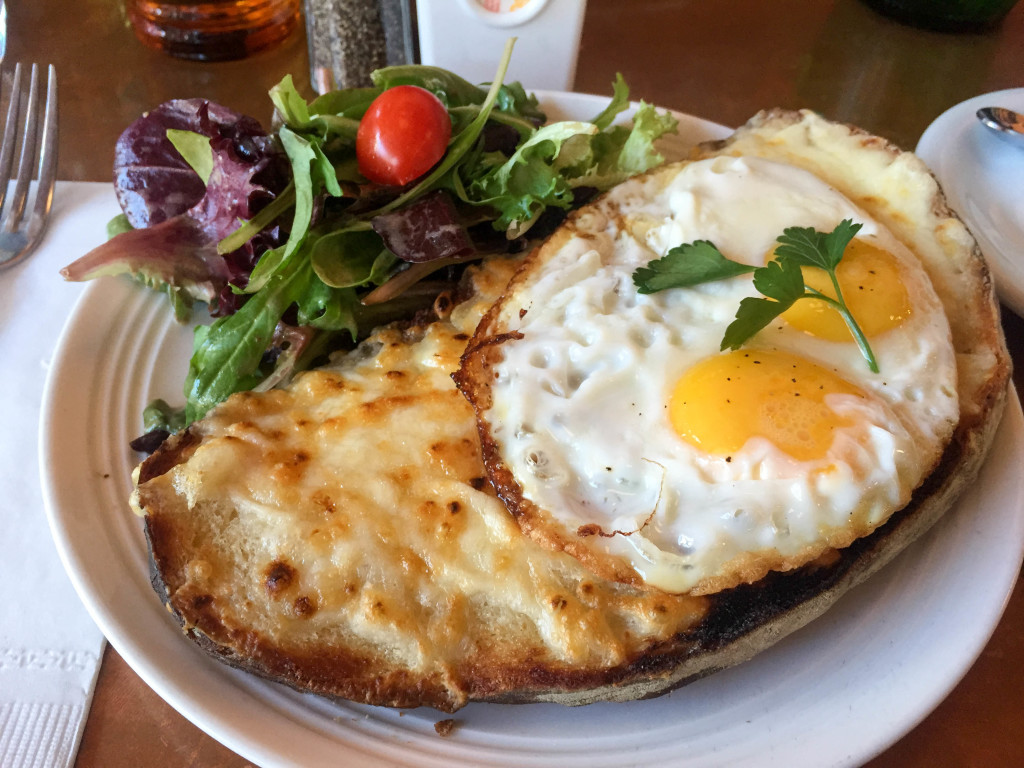
Leslie Bernat taking orders behind the dessert counter. Photo: Raquel Wildes.
With its painted yellow exterior and white lace drapes cinched together, Provence en Boîte brings the authentic feel of a French bistro, as well as its food, to Carroll Gardens in Brooklyn. It is one of 12 French restaurants along Smith Street that cater to an influx of French immigrants.
“When you sit outside during the summer beneath the trees, drinking wine and eating all day, you really feel like you’re in Provence,” said Leslie Bernat, who owns and operates the bistro, which in English means Provence in a Box, with her husband, Jean-Jacques.
Jean-Jacques, 59, and Leslie, 57, were among the first French families to settle in Carroll Gardens 18 years ago, earning them the title of “unofficial mayors,” according to French Morning, the most popular French expat website in New York.
Leslie greets customers with a distinct, “Bonjour! How are you?” over the burr of the espresso maker, her small frame and coiffed blonde hair partially hidden from diners as she busies herself behind a counter. Glass cases hold French goods: freshly baked baguettes, giant meringues, Haribo gummies from the Uzès factory, caramel mille-feuille, eights types of croissants, Celtic water bottled in Vosges de Nord, and, of course, wine from the grape regions.
That’s just what’s listed on the menu. Jean-Jacques says that there is no French dish he cannot make. He may have to pay higher import taxes to get the products he wants, but Jean-Jacques feels that he has the entire French culinary tradition at his disposal, including Ricard Pastis de Marseille, an anise-flavored spirit used for both cooking and drinking. Their most popular dish is the Croque Monsieur—an open-faced ham, egg and cheese sandwich on homemade brioche with béchamel sauce.
A tall man with salt-and-pepper hair, sporting a white double-breasted chef coat and red reading glasses, Jean-Jacques considers himself “old school” when it comes to the rigid cooking techniques typical of French cuisine, but he’s willing to be flexible. “I teach every chef who works for me the art of French pastries, but sometimes the younger chefs want to make them differently,” Jean-Jacques said in his thick accent. “I usually don’t care as long as the end product is the same.” Jean-Jacques spent four years learning to cook in Lyon under French masters Paul Bocuse and Maurice Benachoa.
With almost half of his clientele speaking French, Jean-Jacques knows that his customers can taste the difference between French baking and American knockoffs. He tries to preserve the authenticity of his space as well—from the rust-colored, sponge painted walls to the golden, grape-embellished Provencal cloths and cushions (which Leslie sells in the back of the restaurant). At four in the afternoon on game days, friends—who are more like extended family—line the banquette to watch the European Football League live.

Until recently, most French immigrants settled in scattered areas where job opportunities were likely to be found, as opposed to joining previous French settlers. But French immigrants in New York are beginning to show a desire to preserve their language, culture and cuisine—especially in Carroll Gardens, where the first French-English dual-language program was instituted in a public school four blocks from Provence en Boîte.
Since the program started at P.S. 58 nine years ago, Carroll Gardens has become an informal French enclave. “I’ll be walking around and overhear moms speaking to their kids in French,” said Vilma Heramia, executive director of the Carroll Gardens Association.
The International School of Brooklyn and La Souris Verte, a French immersion toddler playgroup, are a few blocks away from P.S. 58. French children’s books have begun to fill the shelves in the Carroll Gardens public library, and St. Agnes’s Cathedral offers weekly French mass.
While the French Consulate does not require immigrants to register by district, they estimate that around one-third of New York City’s French community lives in Brooklyn. “More immigrants settle down in Brooklyn every year—which seems to appear as the new center of attraction for French immigrants,” according to Damien Saverot, the press officer of the French Consulate in Manhattan. Jean-Jacques estimates that there are between 7,000 and 8,000 French people in the area based on his ‘mayoral’ experience.
When the Bernats moved to Carroll Gardens, none of their French friends wanted to follow suit. “They all lived in Manhattan and sent their kids to Lycée Français,” said Leslie, as she waved her hands in circles to convey her uppity impression of this prestigious private school. But once the program at P.S. 58 began, French immigrants migrated south—and even tried to pay their way into the public school, Leslie says.
These programs have largely been grassroots-lead initiatives by French families like the Bernats, with financial and operational help from the French Embassy. About 300 students at P.S. 58 are part of the French program, and at least half of them are native French speakers, according to Principal Katie Dello Stritto. “And that’s a conservative estimate.”
Eleven dual-language French programs catering to over 1,300 students have been developed elsewhere in the city, with more on the way, making French the second largest dual-language program in the New York school system. Last week, Fabrice Jaumont, the education liaison at the Cultural Services of the French Embassy, dined at the Bernat’s bistro with visitors from Texas and Washington who hope to implement similar programs in their states.
The French embassy supports these initiatives because they believe that language is the key to keeping a culture alive. So is food, the Bernats insist.
Leslie moved to the United States 35 years ago to pursue what she thinks of as the American Dream, an idea that still excites her, even though she’s embarrassed to embrace a cliché. “We want to bring our story and French flavor to the neighborhood,” said Jean-Jacques. “The stories are what make the neighborhood.”
Together with Bar Tabac, another French bistro down the block, Provence en Boîte hosts what organizers call the biggest Bastille Day celebration in the United States every summer. Traffic is halted on Smith Street and thousands of players and spectators swarm the temporary Pétanque courts, the French equivalent of Italian bocce.
“I just hope places like this can stay alive in Carroll Gardens,” said Chloe Kunstler, a French tutor who considers Paris her second home but lives a few blocks away, as she sipped a café au lait during the Arsenal vs. Barcelona game. She has never lived in Paris but has visited many times.
The Bernats don’t seem worried about the future of their restaurant, despite the fact that their daughter, 18, hopes to go into medicine and their son, 16, into business. “I have no idea how we’ll keep the restaurant alive,” Jean-Jacques said with a laugh, “but I hope we can.”
As much as Leslie misses France, she is happy with her life in America. “This is my country,” she said. Her husband, on the other hand, is more nostalgic for the real Provence. Not the one in a box.
“I miss everything about Provence—my friends, the beach, the lavender,” Jean-Jacques said. “It’s a different lifestyle there, stress-free.”

Your Comments